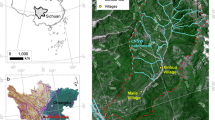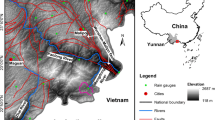Abstract
An increasing number of debris flows in mountainous regions near Beijing have been documented in the last few decades, some of which were triggered by extreme rainstorms. In this paper, we examine a total of 40 landslides and 16 debris flows triggered by an extreme rainstorm on 12 July 2012. Rainfall records were used to check the triggering conditions. Field reconnaissance and measurements, supported by aerial photo interpretation, were conducted to identify the distribution, mobility, and volume change of landslides. This extreme rainstorm provided a higher triggering condition than the required rainfall threshold in the study area. The rainfall intensity during periods of intense rainfall was comparable to some typhoon events and other extreme rainstorms. Records from seven rainfall stations reveal that the rainfall in valley floor areas was higher than that in mountainous and plain areas. The rainfall-induced landslides were small, and most of them were located in terrain with a slope gradient >25° and pelitic dolostone strata underneath. The watersheds have a small area, short stream length, and the debris flow volume is low because of the limited material resources. The landslide-type debris flows exhibit weak mobility as the debris flow deposits mainly consist of gravels. Although the material resources from shallow landslides are small, the debris flow volume is 1.03–4.05 times the initial landslide volume, indicating that the debris flow entrains sediments. Finally, the entrained sediments per channel length and debris flow volume magnification were positively related to the watershed area and channel length, respectively. Our findings proved that an extreme rainstorm can trigger landslides and debris flows in an area where no such hazards were documented before. It is necessary to identify the site prone to landslides and debris flows, which may pose a hidden threaten for local inhabitants.













Similar content being viewed by others
Explore related subjects
Discover the latest articles and news from researchers in related subjects, suggested using machine learning.References
Berti M, Simoni A (2005) Experimental evidences and numerical modelling of debris flow initiated by channel runoff. Landslides 2(3):171–182
Beijing Forestry University (2007) Debris flows and floods in Beijing Mountain regions. China Forestry Publishing House, Beijing
Bugnion L, McArdell BW, Bartelt P, Wendeler C (2012) Measurements of hillslope debris flow impact pressure on obstacles. Landslides 9(2):179–187
Caine N (1980) The rainfall intensity–duration control of shallow landslides and debris flows. Geografiska Annaler. Series a. Phys Geogr 62:23–27
Cannon SH (2001) Debris-flow generation from recently burned watersheds. Environ Eng Geosci 7(4):321–341
Chen H, Petley DN (2005) The impact of landslides and debris flows triggered by typhoon Mindulle in Taiwan. Q J Eng Geol Hydrogeol 38(3):301–304
Cheng JD, Huang YC, Wu HL, Yeh JL, Chang CH (2005) Hydrometeorological and landuse attributes of debris flows and debris floods during typhoon Toraji, July 29-30, 2001 in central Taiwan. J Hydrol 306(1):161–173
Cannon SH, Gartner JE, Wilson RC, Bowers JC, Laber JL (2008) Storm rainfall conditions for floods and debris flows from recently burned areas in southwestern Colorado and southern California. Geomorphology 96(3):250–269
Cui P, Zhu YY, Han YS, Chen XQ, Zhuang JQ (2009) The 12 may Wenchuan earthquake-induced landslide lakes: distribution and preliminary risk evaluation. Landslides 6(3):209–223
Chen NS, Zhou W, Yang CL, Hu GS, Gao YC, Han D (2010) The processes and mechanism of failure and debris flow initiation for gravel soil with different clay content. Geomorphology 121(3):222–230
Chang CW, Lin PS, Tsai CL (2011) Estimation of sediment volume of debris flow caused by extreme rainfall in Taiwan. Eng Geol 123(1):83–90
Cascini L, Cuomo S, Della Sala M (2011) Spatial and temporal occurrence of rainfall-induced shallow landslides of flow type: a case of Sarno-Quindici, Italy. Geomorphology 126(1–2):148–158
Cui P, Zhou GG, Zhu XH, Zhang JQ (2013) Scale amplification of natural debris flows caused by cascading landslide dam failures. Geomorphology 182:173–189
De Haas T, Braat L, Leuven JRFW, Lokhorst IR, Kleinhans MG (2015) Effects of debris flow composition on runout, depositional mechanisms, and deposit morphology in laboratory experiments. J Geophys Res Earth Surf 120(9):1949–1972
Fujii Y (1969) Frequency distribution of the magnitude of landslides caused by heavy rainfall. J Seismic Soc Jpn 22:244–247
Guzzetti F, Malamud BD, Turcotte DL, Reichenbach P (2002) Power-law correlations of landslide areas in central Italy. Earth Planet Sci Lett 195(3):169–183
Gabet EJ, Mudd SM (2006) The mobilization of debris flows from shallow landslides. Geomorphology 74(1–4):207–218
Guo X, Cui P, LiY ML, Ge Y, Mahoney WB (2016) Intensity-duration threshold of rainfall-triggered debris flows in the Wenchuan earthquake affected area, China. Geomorphology 253:208–216
Hovius N, Stark CP, Allen A (1997) Sediment flux from a mountain belt derived by landslide mapping. Geology 25(3):231–234
Hovius N, Stark CP, Chu HT, Lin JC (2000) Supply and removal of sediment in a landslide-dominated mountain belt: central range, Taiwan. J Geol 108(1):73–89
Hungr O, Mcdougall S, Bovis M (2007) Entrainment of material by debris flows. Debris-flow hazards and related phenomena. Springer, Berlin, pp 135–158
Hu K, Wei F, Li Y (2011) Real-time measurement and preliminary analysis of debris-flow impact force at Jiangjia ravine, China. Earth Surf Process Landf 36(9):1268–1278
Hürlimann M, McArdell BW, Rickli C (2015) Field and laboratory analysis of the runout characteristics of hillslope debris flows in Switzerland. Geomorphology 232:20–32
Iverson RM, Reid ME, LaHusen RG (1997) Debris-flow mobilization from landslides1. Annu Rev Earth Planet Sci 25(1):85–138
Iverson RM (2000) Landslide triggering by rain infiltration. Water Resour Res 36(7):1897–1910
Iverson RM, Reid ME, Logan M, LaHusen RG, Godt JW, Griswold JP (2011) Positive feedback and momentum growth during debris-flow entrainment of wet bed sediment. Nat Geosci 4(2):116–121
Iverson RM (2012) Elementary theory of bed-sediment entrainment by debris flows and avalanches. J Geophys Res Earth Surf 117(F3):259–281
Iverson RM, Ouyang C (2015) Entrainment of bed material by earth-surface mass flows: review and reformulation of depth-integrated theory. Rev Geophys 53(1):27–58
Kean JW, Staley DM, Cannon SH (2011) In situ measurements of post-fire debris flows in southern California: comparisons of the timing and magnitude of 24 debris-flow events with rainfall and soil moisture conditions. J Geophys Res Earth Surf 116(F4):759–775
Lin ML, Jeng FS (2000) Characteristics of hazards induced by extremely heavy rainfall in Central Taiwan—typhoon herb. Eng Geol 58(2):191–207
Li XB, Ma ZZ, Yao XY, Jing K, Zhu HY (2008) Current status and comprehensive control strategies of soil erosion for rocky mountain areas in the northern China. Sci Soil Water Conserv 6(1):9–15 (in Chinese)
Luna BQ, Remaître A, Van Asch TW, Malet JP, Van Westen CJ (2012) Analysis of debris flow behavior with a one dimensional run-out model incorporating entrainment. Eng Geol 128:63–75
Malamud BD, Turcotte DL (1999) Self-organized criticality applied to natural hazards. Nat Hazards 20(2):93–116
McCoy SW, Kean JW, Coe J, Staley DM, Wasklewicz TA, Tucker GE (2010) Evolution of a natural debris flow: in situ measurements of flow dynamics, video imagery, and terrestrial laser scanning. Geology 38(8):735–738
Ma C, Hu K, Tian M (2013) Comparison of debris-flow volume and activity under different formation conditions. Nat Hazards 67(2):261–273
Martha TR, Roy P, Govindharaj KB, Kumar KV, Diwakar PG, Dadhwal VK (2014) Landslides triggered by the june 2013 extreme rainfall event in parts of Uttarakhand state, India. Landslides 12(1):135–146
Ma C, Wang YJ, Du C, Wang YQ, Li YP (2016) Variation in initiation condition of debris flows in the mountain regions surrounding Beijing. Geomorphology 273:323–334
Ma C, Wang Y, Hu K, Du C, Yang W (2017) Rainfall intensity–duration threshold and erosion competence of debris flows in four areas affected by the 2008 Wenchuan earthquake. Geomorphology 282:85–95
Parise M, Cannon SH (2012) Wildfire impacts on the processes that generate debris flows in burned watersheds. Nat Hazards 61(1):217–227
Rickenmann D (2005) Runout prediction methods. Debris-flow hazards and related phenomena. Springer, Berlin
Reid ME, Coe JA, Brien DL (2016) Forecasting inundation from debris flows that grow volumetrically during travel, with application to the Oregon coast range, USA. Geomorphology 273:396–411
Shieh CL, Chen YS, Tsai YJ (2009) Variability in rainfall threshold for debris flow after the Chi-Chi earthquake in central Taiwan, China. Int J Sediment Res 24(2):177–188
Scheidl C, Rickenmann D (2010) Empirical prediction of debris-flow mobility and deposition on fans. Earth Surf Process Landf 35(2):157–173
Stoffel M, Bollschweiler M, Beniston M (2011) Rainfall characteristics for periglacial debris flows in the Swiss alps: past incidences-potential future evolutions. Clim Chang 105(1–2):263–280
Sun J, Zhao S, Shenming FU, Wang H, Linlin AZ (2013) Multi-scale characteristics of record heavy rainfall overBbeijing area on July 21, 2012. Chin J Atmos Sci 37(3):705–718 (in Chinese)
Tang C, Zhu J, Ding J, Cui XF, Chen L, Zhang JS (2011) Catastrophic debris flows triggered by a 14 August 2010 rainfall at the epicenter of the Wenchuan earthquake. Landslides 8(4):485–497
Tang C, Van Asch TW, Chang M, Chen GQ, Zhao XH, Huang XC (2012) Catastrophic debris flows on 13 August 2010 in the Qingping area, southwestern China: the combined effects of a strong earthquake and subsequent rainstorms. Geomorphology 139:559–576
Tsou CY, Feng ZY, Chigira M (2011) Catastrophic landslide induced by typhoon Morakot, Shiaolin, Taiwan. Geomorphology 127(3):166–178
Tang P, Hongrang H, Yang X, Yan Y, Wang Y, Miao Z (2015) Research and analysis of dry intrusion during Beijing ‘7·21’ extreme torrential rain. Plateau Meteorol 34(1):210–219 (in Chinese)
Wang G, Sassa K (2003) Pore-pressure generation and movement of rainfall-induced landslides: effects of grain size and fine-particle content. Eng Geol 69(1–2):109–125
Wang G, Sassa K, Fukuoka H (2003) Downslope volume enlargement of a debris slide–debris flow in the 1999 Hiroshima, Japan, rainstorm. Eng Geol 69(3–4):309–330
Wu CH, Chen SC, Chou HT (2011) Geomorphologic characteristics of catastrophic landslides during typhoon Morakot in the Kaoping watershed, Taiwan. Eng Geol 123(1):13–21
Wang J, Cui C, Wang X, Cui W (2014) Analysis on water vapor transport and budget of the severe torrential rain over Beijing region on 21 July 2012. Meteorol Mon 40(2):133–145 (in Chinese)
Wang F, Wu YH, Yang H, Tanida Y, Kamei A (2015) Preliminary investigation of the 20 August 2014 debris flows triggered by a severe rainstorm in Hiroshima City, Japan. Geoenviron Disasters 2(1):17
Yu XD (2012) Investigation of Beijing extreme flooding event on 21 July 2012. Meteorol Mon 68(3):667–683 (in Chinese)
Zhou GGD, Cui P, Chen HY, Zhu XH, Tang JB, Sun QC (2013) Experimental study on cascading landslide dam failures by upstream flows. Landslides 10(5):12–17
Zhou Y, Liu L, Zhu K, Li JT (2014) Simulation and evolution characteristics of mesoscale systems occurring in Beijing on 21 July 2012. Chin J Atmos Sci 38(5):885–896 (in Chinese)
Acknowledgments
This study was supported by the National Forestry Public Welfare Research Project from State Forestry Administration (Grant no. 201404209), and the National Natural Science Foundation of China (Grant no. 41702369 and 41601004). The authors acknowledge the Beijing Meteorological Service for providing rainfall data.
Author information
Authors and Affiliations
Corresponding author
Rights and permissions
About this article
Cite this article
Li, Y., Ma, C. & Wang, Y. Landslides and debris flows caused by an extreme rainstorm on 21 July 2012 in mountains near Beijing, China. Bull Eng Geol Environ 78, 1265–1280 (2019). https://doi.org/10.1007/s10064-017-1187-0
Received:
Accepted:
Published:
Issue Date:
DOI: https://doi.org/10.1007/s10064-017-1187-0




